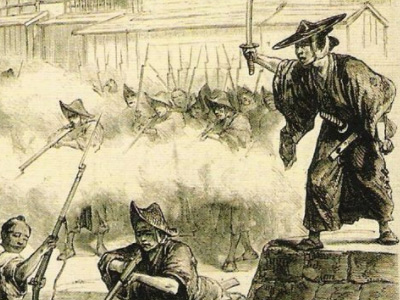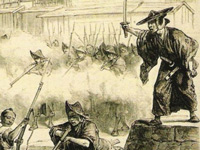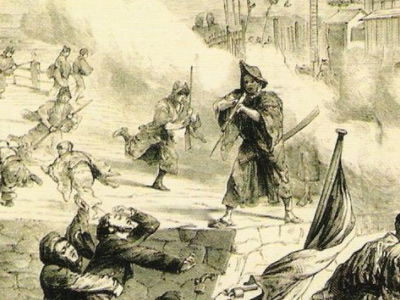Boshin War (1868-1869)

Aftermath
Following victory, the new government proceeded with unifying the country under a single, legitimate and powerful rule by the imperial court. The emperor's residence was effectively transferred from Kyoto to Edo at the end of 1868, and the city renamed to Tokyo.
The military and political power of the domains was progressively eliminated, and the domains themselves were soon transformed into prefectures, whose governors were appointed by the emperor. A major reform was the effective expropriation and abolition of the samurai class, allowing many samurai to change into administrative or entrepreneurial positions, but forcing many others into poverty.
The southern domains of Satsuma, Chōshū and Tosa, having played a decisive role in the victory, occupied most of the key posts in government for several decades following the conflict, a situation sometimes called the "Meiji oligarchy" and formalized with the institution of the genrō. In 1869, the Yasukuni Shrine in Tokyo was built in honour of the victims of the Boshin War.
Some leading partisans of the former Shogun were imprisoned, but narrowly escaped execution. This clemency derives from the insistence of Saigō Takamori and Iwakura Tomomi, although much weight was placed on the advice of Parkes, the British The United Kingdom of Great Britain and Ireland was a sovereign state in Northwestern Europe that comprised the entirety of the British Isles between 1801 and 1922. The United Kingdom, having financed the European coalition that defeated France during the Napoleonic Wars, developed a large Royal Navy that enabled the British Empire to become the foremost world power for the next century. envoy. He had urged Saigō, in the words of Ernest Satow, "that severity towards Keiki [Yoshinobu] or his supporters, especially in the way of personal punishment, would injure the reputation of the new government in the opinion of European Powers." After two or three years of imprisonment, most of them were called to serve the new government, and several pursued brilliant careers. Enomoto Takeaki, for instance, would later serve as an envoy to Russia
The United Kingdom of Great Britain and Ireland was a sovereign state in Northwestern Europe that comprised the entirety of the British Isles between 1801 and 1922. The United Kingdom, having financed the European coalition that defeated France during the Napoleonic Wars, developed a large Royal Navy that enabled the British Empire to become the foremost world power for the next century. envoy. He had urged Saigō, in the words of Ernest Satow, "that severity towards Keiki [Yoshinobu] or his supporters, especially in the way of personal punishment, would injure the reputation of the new government in the opinion of European Powers." After two or three years of imprisonment, most of them were called to serve the new government, and several pursued brilliant careers. Enomoto Takeaki, for instance, would later serve as an envoy to Russia Russian Empire was an empire and the final period of the Russian monarchy from 1721 to 1917, ruling across large parts of Eurasia. The rise of the Russian Empire coincided with the decline of neighbouring rival powers: the Swedish Empire, the Polish–Lithuanian Commonwealth, Qajar Iran, the Ottoman Empire, and Qing China. Russia remains the third-largest empire in history, surpassed only by the British Empire and the Mongol Empire. and China and as the education minister.
Russian Empire was an empire and the final period of the Russian monarchy from 1721 to 1917, ruling across large parts of Eurasia. The rise of the Russian Empire coincided with the decline of neighbouring rival powers: the Swedish Empire, the Polish–Lithuanian Commonwealth, Qajar Iran, the Ottoman Empire, and Qing China. Russia remains the third-largest empire in history, surpassed only by the British Empire and the Mongol Empire. and China and as the education minister.
The Imperial side did not pursue its objective to expel foreign interests from Japan, but instead shifted to a more progressive policy aiming at the continued modernization of the country and the renegotiation of unequal treaties with foreign powers, later under the "rich country, strong army" (富国強兵 fukoku kyōhei) motto. The shift in stance towards the foreigners came during the early days of the civil war: on April 8, 1868, new signboards were erected in Kyoto (and later throughout the country) that specifically repudiated violence against foreigners. During the course of the conflict, Emperor Meiji personally received European envoys, first in Kyoto, then later in Osaka and Tokyo. Also unprecedented was Emperor Meiji's reception of Alfred, Duke of Edinburgh, in Tokyo, "'as his equal in point of blood.'"
Although the early Meiji era witnessed a warming between the imperial court and foreign powers, relations with France temporarily soured due to the initial support by France Second French Empire was the 18-year Imperial Bonapartist regime of Napoleon III from 14 January 1852 to 27 October 1870. The Second Empire is given high credit for the rebuilding of Paris with broad boulevards, striking public buildings, and elegant residential districts for upscale Parisians. In international policy, Napoleon III tried to emulate his uncle Napoleon I, engaging in numerous imperial ventures around the world as well as several wars in Europe. for the Shogun. Soon however a second military mission was invited to Japan in 1874, and a third one in 1884. A high level of interaction resumed around 1886, when France helped build the Imperial Japanese Navy's first large-scale modern fleet, under the direction of naval engineer Louis-Émile Bertin. The modernization of the country had started during the last years of the Shogunate, and the Meiji government ultimately adopted the same policy.
Second French Empire was the 18-year Imperial Bonapartist regime of Napoleon III from 14 January 1852 to 27 October 1870. The Second Empire is given high credit for the rebuilding of Paris with broad boulevards, striking public buildings, and elegant residential districts for upscale Parisians. In international policy, Napoleon III tried to emulate his uncle Napoleon I, engaging in numerous imperial ventures around the world as well as several wars in Europe. for the Shogun. Soon however a second military mission was invited to Japan in 1874, and a third one in 1884. A high level of interaction resumed around 1886, when France helped build the Imperial Japanese Navy's first large-scale modern fleet, under the direction of naval engineer Louis-Émile Bertin. The modernization of the country had started during the last years of the Shogunate, and the Meiji government ultimately adopted the same policy.
Upon his coronation, Meiji issued his Charter Oath, calling for deliberative assemblies, promising increased opportunities for the common people, abolishing the "evil customs of the past", and seeking knowledge throughout the world "to strengthen the foundations of imperial rule". Prominent reforms of the Meiji government included the 1871 abolition of the domain system, by which the feudal domains and their hereditary rulers were replaced by prefectures with governors appointed by the emperor. Others included the introduction of compulsory schooling and the abolition of Confucian class distinctions. The reforms culminated in the 1889 issuance of the Meiji Constitution. However, despite the support given to the imperial court by samurai, many of the early Meiji reforms were seen as detrimental to their interests: the creation of a conscript army made of commoners, as well as the loss of hereditary prestige and stipends antagonized many former samurai. Tensions ran particularly high in the south, leading to the 1874 Saga Rebellion, and a rebellion in Chōshū in 1876. Former samurai in Satsuma, led by Saigō Takamori, who had left government over foreign policy differences, started the Satsuma Rebellion in 1877. Fighting for the maintenance of the samurai class and a more virtuous government, their slogan was "new government, high morality" (新政厚徳 shinsei kōtoku). It ended with a heroic but total defeat at the Battle of Shiroyama.
HISTORY

RESOURCES
This article uses material from the Wikipedia article "Boshin War (1868-1869)", which is released under the Creative Commons Attribution-Share-Alike License 3.0.
© Stories Preschool. All Rights Reserved.









